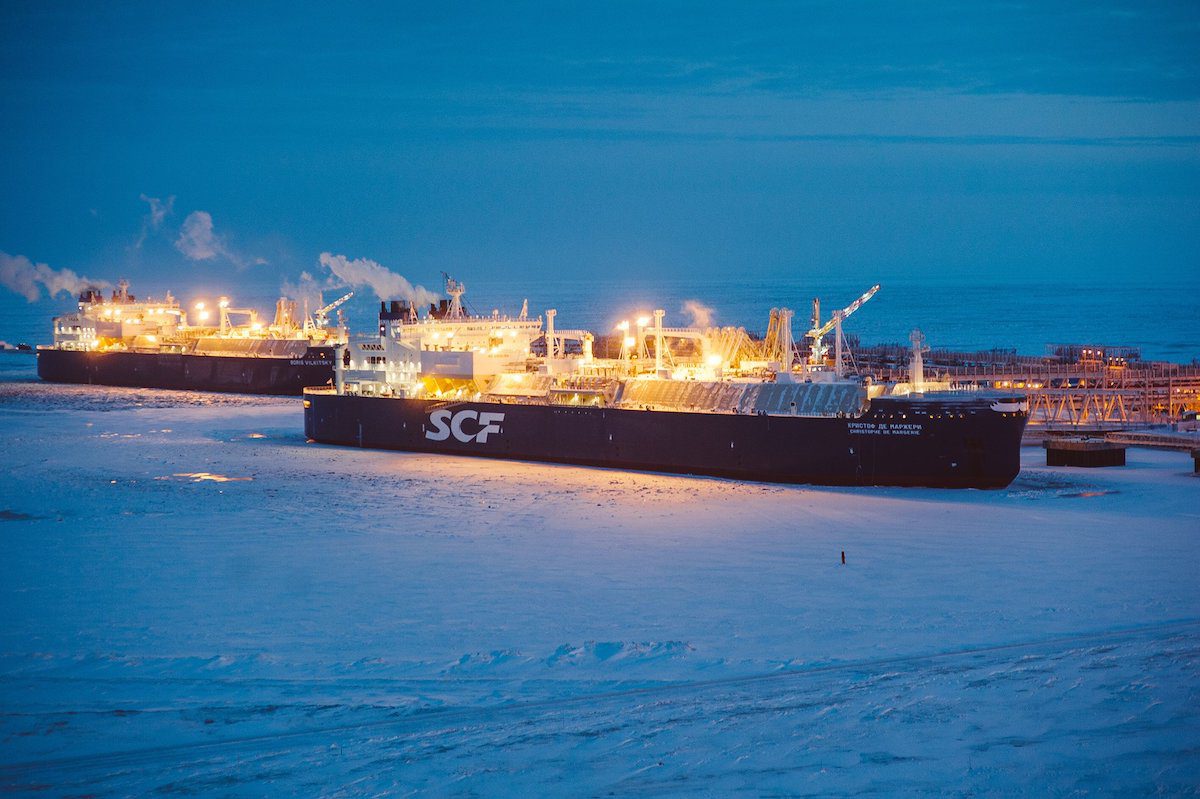File Photo: Two Arc7 ice-class LNG carriers load LNG produced at Yamal LNG at the port of Sabetta, Russia. Photo: Novatek
By Anna Shiryaevskaya and Elena Mazneva (Bloomberg) — On a hot sunny day in July, Europe’s largest port is busy loading super-chilled liquefied natural gas onto a tanker, creating snow flurries during a heat wave.
The cargo loaded at the Gate terminal in Rotterdam, which was built to import the fuel. Around the same time, a vessel from the Russian Arctic region arrived with another batch of LNG, according to ship-tracking data on Bloomberg. It’s an example of how Europe’s LNG terminals are keeping busy even as the fuel mostly heads for other higher-paying markets such as Asia.
With Europe absorbing record amounts of pipeline gas from Russia and prices for the fuel stronger in Asia, LNG terminals in Europe are finding work by transferring cargoes from one vessel onto another or shifting them into storage for future loadings. The gas is so cold that sections of pipes carrying it aboard are covered in frost, and flakes of snow drift into the air from the loading arms. LNG is gas that’s chilled to minus 160 degrees Celsius (minus-260 Fahrenheit) until it becomes a liquid that can be poured into tankers.
The scene is a good sign for Novatek PJSC and its partners, which are using specially-built tankers to export the LNG from their Yamal LNG plant in Northern Siberia. These ships can navigate through the region’s thick ices, but they’re too expensive to use on long journeys. The solution? Transfer the cargoes from ice-class tankers in northern European ports and onto normal ships for the long journey east. Rotterdam is one of the places they’re working.
“Yamal cargoes, in the winter especially, coming down into Europe can either be injected into the gas system here or reloaded for onward transportation as they come off the specialized tankers,” Paul Wogan, chief executive officer of the LNG ship owner GasLog Ltd., said on a visit to the GasLog Hong Kong vessel as it was loading in Rotterdam. “That’s very much price driven arbitrage, but it is creating more liquidity to be able to play that price driven arbitrage. Yamal is probably the bigger factor allowing for seeing reloads out of Europe.”
The LNG carrier GasLog Hong Kong is on long-term charter to the French oil major Total SA. The 290-meter-long ship is one of three new GasLog ships delivered earlier in 2018. They incorporate the latest developments in containment technology and propulsion, which the owner says results in the lowest unit freight costs among the global LNG shippers.
With no detailed destination given, GasLog Hong Kong vessel appears to be headed for the Northeast Coast of the U.S., as it was crossing the ocean on Monday, according to ship-tracking data on Bloomberg. An import terminal in Boston received a cargo from northwest European storage tanks in January, with some of the LNG originating from Yamal LNG.
Traders have for years been reloading cargoes from Europe’s terminals, sending them to Asia when the market made that more attractive than keeping the fuel for domestic use. Trans-shipments of Yamal cargoes started in December under deals done by the project’s operators, Novatek, Total SA and their Chinese partners.
These transfers can be done either directly from the Yamal ice-class ship onto a conventional tanker, or by using the terminal’s storage tanks as an intermediary. In the latter case, the gas is mixed with the fuel already sitting in the tanks, blurring the Russian origin of the commodity.
Work trans-shipping Yamal cargoes helps LNG terminals in northwest Europe, which have been standing idle more often than their developers had expected. Europe holds about 20 percent of the world’s LNG receiving capacity, and those regasification plants worked at rate of 27 percent of capacity in 2017. In the Netherlands utilization was as low as 9 percent, according to a report by the industry lobby group International Gas Union.
Some LNG brought from Yamal to Europe was unloaded for local consumption. Most has been exported onwards, spurred by higher prices in Asia.
That work may be a temporary phenomena.
Europe may see fewer LNG cargoes from Russia’s Arctic during the summer season. Then, ships are increasingly able to pass the Northern Sea Route to Asia, which is isn’t used in the winter due to heavy ice.
China on Thursday received two cargoes from Yamal LNG, the first vessels to cross the Arctic passage without additional ice-breaking assistance since the plant was opened last year. The third carrier is now heading to China using the same route and is set to arrive on July 31.
The voyage of the first vessels took 19 days compared to 35 for the traditional route via the Suez Canal and the Strait of Malacca, according to Yamal LNG’s main owner, Novatek. That saves the company some $0.65 per million British thermal units on transportation costs, according to estimates from VTB Capital and Bloomberg New Energy Finance. Yamal LNG may save $46 million on shipping to Asia for the remainder of the year, BNEF said in a note.
What may keep the terminals such as Rotterdam in the Netherlands and Montoir in France upbeat is the start of Yamal’s second production plant next month, which will double the shipments. When ice starts blocking the Northern Sea Route navigation, the Yamal tankers will head westward again.
“What is happening with Yamal is going to increase reloads in Europe,” Wogan said.
© 2018 Bloomberg L.P

 Join The Club
Join The Club











